The Cadaghi Story
by Bob Luttrell (B Ag Sc)
www.bobthebeeman.com.au
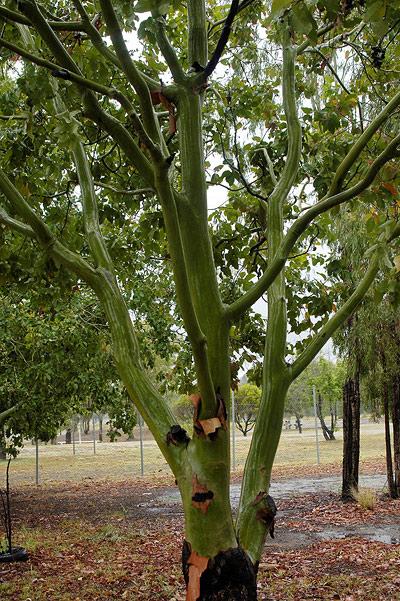 This tree, Corymbia torelliana, grows naturally in a small area near Kuranda, in North Queensland. There it existed inconspicuously , including co-existing with the local stingless bees. It attracted the attention of landscapers and was brought south because of it high rate of growth, attractive green bark especially when wet, and even more attractive red, hairy juvenile growth. Even as it was being propagated for release there were concerns, and one person had to make the decision for release. Fatefully that was done, and the rest as they say is history.
This tree, Corymbia torelliana, grows naturally in a small area near Kuranda, in North Queensland. There it existed inconspicuously , including co-existing with the local stingless bees. It attracted the attention of landscapers and was brought south because of it high rate of growth, attractive green bark especially when wet, and even more attractive red, hairy juvenile growth. Even as it was being propagated for release there were concerns, and one person had to make the decision for release. Fatefully that was done, and the rest as they say is history.
The tree has been widely planted throughout Queensland in many regions where its rapid growth rate ensured its demand. It was also grown down into NSW. Then gardeners began to notice some negatives, the sooty mould that developed on plants under the leaf canopy was among the first negative. Then when it got big enough to flower, and the seed capsules matured, stingless bee keepers began noticing a new behavioural anomaly with their bees. There have been many reasons proposed for the problems experienced with cadaghi, poisonous pollen is among them. That, I can assure readers is not the case. As a forage tree, it is a perfectly normal tree of the Corymbia group, it provides nectar and pollen in October/November in the years that it flowers, and not every tree flowers every year. The resin which when collected by the bees is clear and golden, becomes a distinctive creamy colour when in the colony.
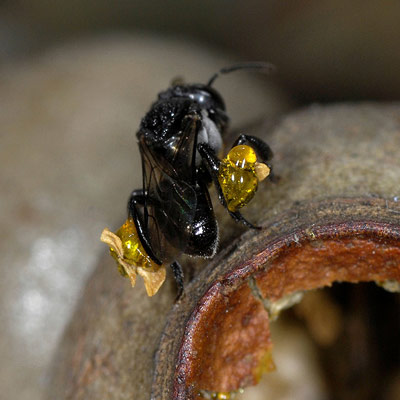 The challenge comes when the tree sets seed and when the seed capsules dry to release their seed. Then a rather unique occurrence, called mellitochory, takes place. This is where the tree offers a reward (resin) to attract an insect ( the stingless bee) to its seed capsule and as a result gets its seed distributed over a far wider range than would have been possible from just a stationary tree. My observations show that my bees have flown 1km or just over to collect this resin, and brought seed all the way back. They would also have dropped seed on the flight path. That is very extensive spread of seed, and those trees are now coming to flowering. The bees have changed the character of the landscape by spreading these trees.
The challenge comes when the tree sets seed and when the seed capsules dry to release their seed. Then a rather unique occurrence, called mellitochory, takes place. This is where the tree offers a reward (resin) to attract an insect ( the stingless bee) to its seed capsule and as a result gets its seed distributed over a far wider range than would have been possible from just a stationary tree. My observations show that my bees have flown 1km or just over to collect this resin, and brought seed all the way back. They would also have dropped seed on the flight path. That is very extensive spread of seed, and those trees are now coming to flowering. The bees have changed the character of the landscape by spreading these trees.
What is so different about the seed setting process of the Cadaghi?
Inside the seed capsule are the normal developing seeds, pollinated by the activities of the bees, and possibly a few other larger pollinaters . In the green seed capsule, they are surrounded by a moist pithy material, but it has vesicles of pure resin. As the maturation process takes place, moisture disappears, and the resin is released. All that remains is for the operculum of the seed capsule to break open for the cycle involving the bee to be completed. Cadaghi is one of the few Corymbias where the opening is large enough to allow the entry of a stingless bee. The resin contained can easily be smelled by them, and indeed by us. In the season, January/February is the time for resin release, the whole yard will smell of this resin when there are several colonies working the tree. Many people regard it with dread, some move colonies, but to me, my thoughts are much more benign. The bees will seek the resin out at long distance, I have established that to 1.2km, though I do live in an area with limited resin resources of any type, and have many colonies.
That is the first thing about its difference in pattern of use from NQ to here in the rest of Queensland. I believe that in the north, there are many more sources of resin available over the season, and the bees do not build up a ‘deficit’ demand for resin. There is no need to rush to collect this resin when it does become available.
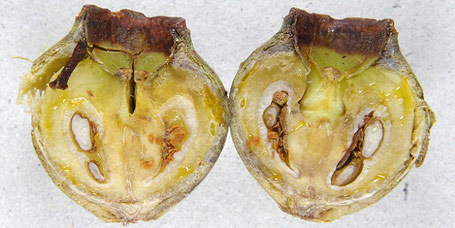 |
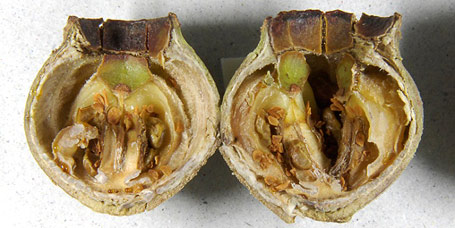 |
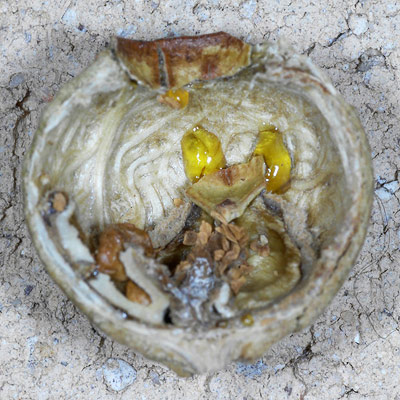 These 3 photos of sectioned seed capsules show the ripening process. Top left shows the pith filled pod, above is the pith largely dry, and to the left droplets of the golden resin are clearly visible, along with seeds and chaff. By this time the operculum is broken and the bee can get in to collect the valued product. That is another factor, the resin clearly meets the need of the bees for resin. They use resin for structure, and chemically for colony hygiene. The chemical components responsible for the odour no doubt allow them to identify which resin products are of greatest use to them. This one is high on their list, and I believe that they are unlikely to have made a decision that is incorrect, for them.
These 3 photos of sectioned seed capsules show the ripening process. Top left shows the pith filled pod, above is the pith largely dry, and to the left droplets of the golden resin are clearly visible, along with seeds and chaff. By this time the operculum is broken and the bee can get in to collect the valued product. That is another factor, the resin clearly meets the need of the bees for resin. They use resin for structure, and chemically for colony hygiene. The chemical components responsible for the odour no doubt allow them to identify which resin products are of greatest use to them. This one is high on their list, and I believe that they are unlikely to have made a decision that is incorrect, for them.
However, what the bees have not adjusted to, is that we have put them into the confined and regimented space of a box. I have opened many colonies in logs, and other natural structures that contain large amounts of the resin of Cadaghi. I have not seen adverse structural effects, but ordered placement of the resin around the outside of the nests in the generous storage areas that are normally present in such structures. Indeed it seems to be mainly placed around the outside in a very orderly fashion.
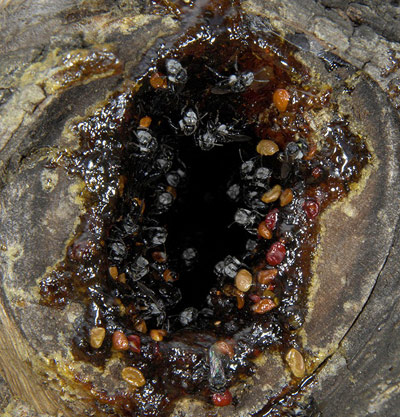 This photo shows the seed collection early in the season on a newly relocated colony. It can of course get very much heavier and thicker than this.
This photo shows the seed collection early in the season on a newly relocated colony. It can of course get very much heavier and thicker than this.
I have a couple of log and box colonies under a row of Cadaghi trees, and each year the resin and seeds build up at the entrance. From here the resin seems to be removed leaving the seeds to drop. The bees seem to be using the outside area at the front of the nest, this is T carbonaria, to make use of heat from the sun, to process the seeds and resin. They can remove the resin to take just that component inside.
The challenge comes over what happens to all the re-located seeds. The bees do not intentionally collect these seeds. When they enter the seed capsule, the space is limited, and the process is to collect the very sticky resin in their mouth parts, they transfer to their corbicula. It is a fascinating exercise, and very easy to bump into the seeds and chaff lying inside the seed capsule. That way, the seeds become attached to the bee. It is accidental, not done on purpose, and the bees do go to some trouble to remove the seeds. At one colony I even saw a small swarm of bees where the intention seemed to be dislodging the seeds. It is as though the bees do not want them in the nest, they know they later have to be removed as rubbish.
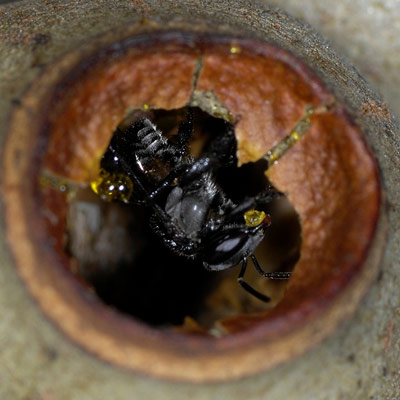 |
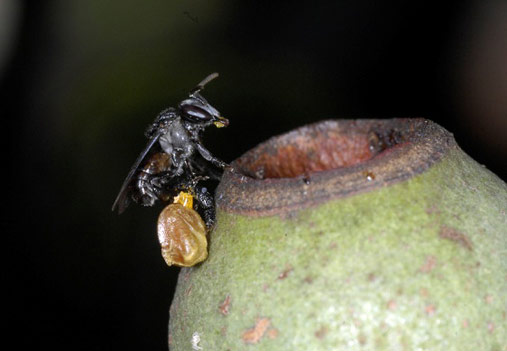
Here a forager can be seen with resin in its mouth and on its corbicula and below an out sized seed load. |
The amount of seed can be very large, and this is one of the most extreme that I have seen, yet the bees very purposefully kept their one entrance clear. I make this point, because it seems to be that when the entrances in the boxes we give them block, that disasters occur.

Now the inside of this colony was of course similarly heavily coated with cadaghi resin. It is of course in a water meter box, sadly taken before I was able to get meaningful data on the temperatures in there. From other such situations, I know this to be one of the most favoured locations that our stingless bees can pick in which to set up a colony. The temperature is stabilised by the proximity to the earth, and normally there is strategic shade, though it takes very little. It is easy for the bees to maintain their 25 – 28 deg desired range, with the peaks and troughs taken off by the location.
In the box the amount of resin collected and separated from seed is very obvious.
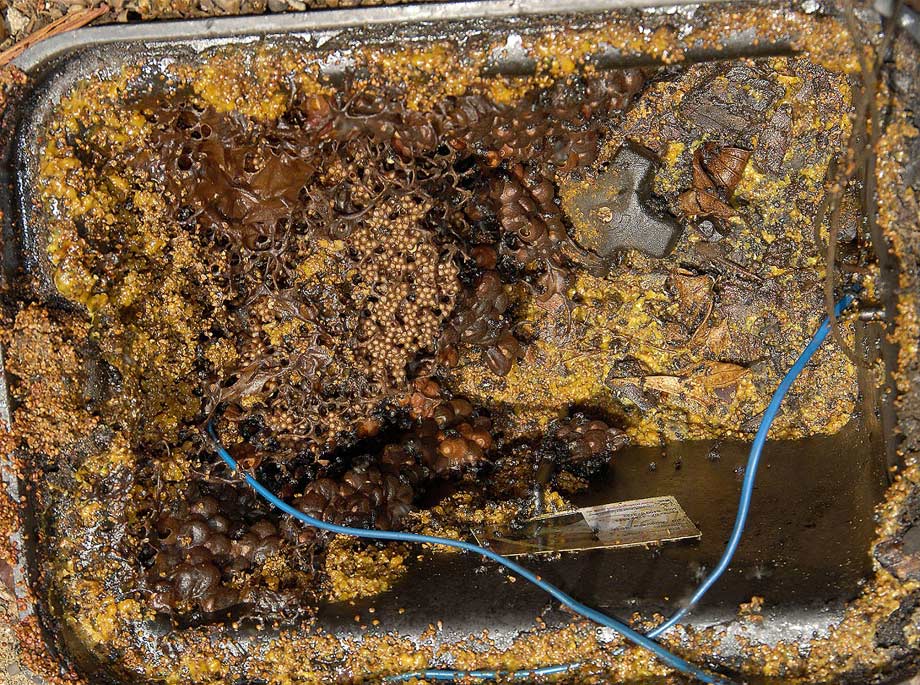
The pure Cadaghi resin has been deposited on whatever horizontal surfaces are available as is obvious. The base of the box, and around the rim. In the crowded boxes used for our stingless bees, it seems that across under the lid is a favourite place, although I see that with taller boxes this is not the case. It is going on the sides, or the top corners and sides of the top boxes and honey supers. The latter becomes an issue when trying to get honey of course, regardless of box design I find.
There is a potential market for the various resins that stingless bees collect, and they do store it in species specific depots. In an observation box that I have with a large observation panel, I can easily see the common bloodwood resin ( another Corymbia), some Cadaghi, a small amount of a pure white resin kept very distinct, and the golden resin of Pinus or Aruaucaria. Perhaps there is Callitris in that. Why they keep the species separate, I do not know, but it is obvious that they do. Then there are depots of a mixed resin/propolis product that appears to be a defensive material. It could be the precursor to be mixed with wax for cerumen, but is of very high value to the bees. If an inspection panel is replaced, this is the product that is scavenged by other stingless bees first, and totally. This product is also definitely stored on the ledges provided by the rebates in my boxes.
It would also be very easy to collect resin of a particular plant species, should that be wanted. I look for a time when I can add a hardwood resin such as Turpentine (Syncarpia glomulifera) to the wax/rosin mix that I use to dip my boxes, as a timber preservative. There are options that can be presented here, with the right box adaptation.
The seeds dispersed by the bees come up in their hundreds in suitable spots, and below is a cluster of 4 seedlings, the largest showing the pink hairy juvenile growth typical of the tree.
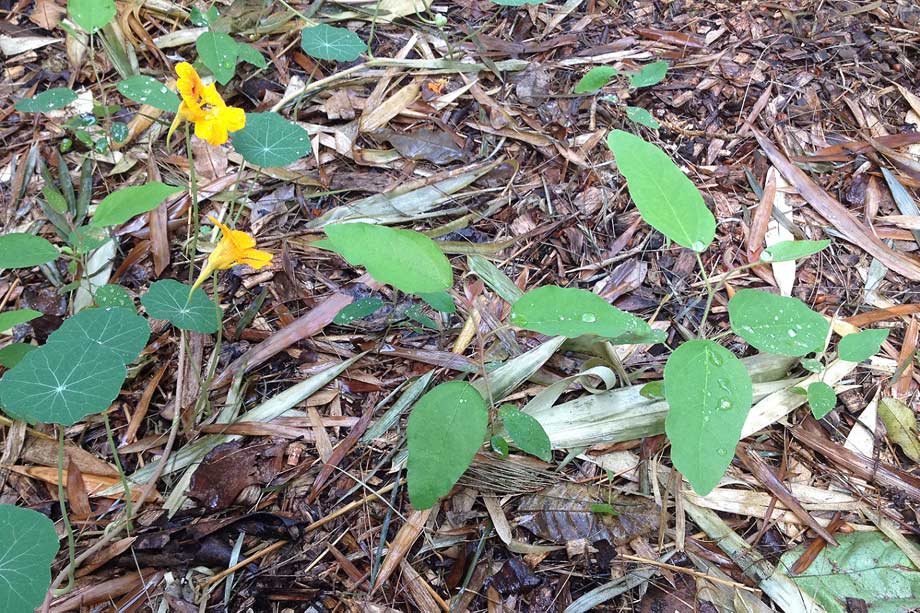
Boxes for stingless bees and cadaghi
I have left this topic until the end, because it is likely to raise most discussion, and probably differences of opinion. I have made my decisions in this, others will have different views.
What I have seen and heard, is that boxes with a single entrance, and where that entrance is low in the box are vulnerable to blockage, and losses. Those losses tend to be blamed on cadaghi, even though the losses come at the hottest part of the year. Other factors could be involved, but an entrance in a low position makes a blockage more likely, and over-heating will follow very quickly if that happens. Such designs still exist out there today, on the internet even, widely viewed and copied. If that entrance is not round, but a slit, it is even worse. Remember that an entrance can block on the inside, as well as on the outside, when the resin become more fluid with heat, and it is low on the box. The inside cannot be seen nor cleared. This loss is not due to cadaghi, but the box design. Simply changing the position of that entrance position upwards will make a big difference in losses. Even the best of our efforts can be undone, by the structure built by the bees inside. Inside the entrance of the common boxes is normally a mass of resin material, not at all what the bees build given the chance.
As a very minimum, boxes should have entrances well up the centre of the box, and preferably have two entrances at least. They should be 12mm diameter, with the bees allowed to modify size to suit. The objective is to get any buildup of material, or slump of material, to fall past the entrance, not over it if this is the problem. My Aussie INPA box has an entrance in each level in the corner, plus one in the base. Those entrances open into the rebate located around the inside of the sidewall sections of each level, and the corner allows the choice of two directions. The very purpose of this rebate is to provide an increased area of level surface within the box, close to the entrances for the storage of resin, and that is how it seems to be used.
Perhaps an internal overhang built into that location will minimise this in other boxes . The entrance opening into the rebate achieves exactly this, resin/seed would slide past if such were to happen, leaving at worst, loosely packed seed as a blockage. People reading I am sure could come up with endless ways to achieve this on the inside of the box.
Temperature is crucial to the whole process. The resin is collected in January/February, the hottest part of the year. If a box containing a large amount of cadaghi resin overheats, the resin releases volatile components, and this puts the bees at even more stress. I do not have evidence to say this is toxic, but certainly it is unpleasant. A single entrance does not help, a second higher entrance becomes essential. It matters not whether it faces front or back. The bees may seem to largely close it off, but if there is an opening in it, behind will be a structure with which the bees are able to ventilate. Even with clear inspection panels, the bees may leave an edge unsealed, yet build the protective structure, and with just a few bees can shift a surprising amount of air. It does not take just a round opening to ventilate.
In honey supers, this and other resins tend to accumulate in the top corners of the walls and roof where that is fixed. It obstructs easy collection of honey if the amount is excessive and with Cadaghi, it can be present in considerable amounts. Boxes need to be cleaned of this resin accumulation, just another nuisance of a job, for seemingly no benefit. The task itself is very interesting.


